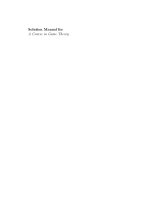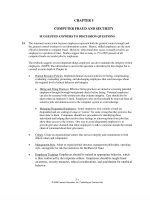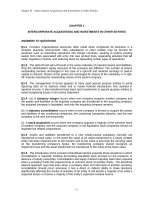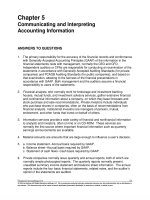Solution manual investment 12thbodie investments 12e SM CH05
Bạn đang xem bản rút gọn của tài liệu. Xem và tải ngay bản đầy đủ của tài liệu tại đây (216.24 KB, 7 trang )
CHAPTER 5: INTRODUCTION TO RISK, RETURN, AND
THE HISTORICAL RECORD
CHAPTER 5: INTRODUCTION TO RISK, RETURN, AND
THE HISTORICAL RECORD
PROBLEM SETS
1.
The Fisher equation predicts that the nominal rate will equal the equilibrium
real rate plus the expected inflation rate. Hence, if the inflation rate
increases from 3% to 5% while there is no change in the real rate, then the
nominal rate will increase by 2%. On the other hand, it is possible that an
increase in the expected inflation rate would be accompanied by a change in
the real rate of interest. While it is conceivable that the nominal interest rate
could remain constant as the inflation rate increased, implying that the real
rate decreased as inflation increased, this is not a likely scenario.
2.
If we assume that the distribution of returns remains reasonably stable over
the entire history, then a longer sample period (i.e., a larger sample)
increases the precision of the estimate of the expected rate of return; this is a
consequence of the fact that the standard error decreases as the sample size
increases. However, if we assume that the mean of the distribution of returns
is changing over time but we are not in a position to determine the nature of
this change, then the expected return must be estimated from a more recent
part of the historical period. In this scenario, we must determine how far
back, historically, to go in selecting the relevant sample. Here, it is likely to
be disadvantageous to use the entire data set back to 1880.
3.
1 rReal
4.
For the money market fund, your holding-period return for the next year
depends on the level of 30-day interest rates each month when the fund rolls
over maturing securities. The one-year savings deposit offers a 5% holding
period return for the year. If you forecast that the rate on money market
instruments will increase significantly above the current 3% yield, then the
money market fund might result in a higher HPR than the savings deposit.
The 20-year Treasury bond offers a yield to maturity of 5% per year, which
is 100 basis points higher than the rate on the one-year savings deposit;
however, you could earn a one-year HPR much less than 4% on the bond if
long-term interest rates increase during the year. If Treasury bond yields rise
above 5%, then the price of the bond will fall, and the resulting capital loss
will wipe out some or all of the 5% return you would have earned if bond
yields had remained unchanged over the course of the year.
1 rNominal 1 .45
1.1154 � rReal 11.54%
1 i
1 .30
5-1
Copyright © 2020 McGrawHill Education. All rights reserved. No reproduction or distribution without the prior written
consent of McGrawHill Education.
CHAPTER 5: INTRODUCTION TO RISK, RETURN, AND
THE HISTORICAL RECORD
5.
6.
7.
a.
If businesses reduce their capital spending, then they are likely to
decrease their demand for funds. This will shift the demand curve in
Figure 5.1 to the left and reduce the equilibrium real rate of interest.
b.
Increased household saving will shift the supply of funds curve to the
right and cause real interest rates to fall.
c.
Open market purchases of U.S. Treasury securities by the Federal
Reserve Board are equivalent to an increase in the supply of funds (a
shift of the supply curve to the right). The FED buys treasuries with
cash from its own account or it issues certificates which trade like
cash. As a result, there is an increase in the money supply, and the
equilibrium real rate of interest will fall.
a.
The “Inflation-Plus” CD is the safer investment because it guarantees the
purchasing power of the investment. Using the approximation that the real
rate equals the nominal rate minus the inflation rate, the CD provides a real
rate of 1.5% regardless of the inflation rate.
b.
The expected return depends on the expected rate of inflation over the next
year. If the expected rate of inflation is less than 3.5% then the
conventional CD offers a higher real return than the inflation-plus CD; if
the expected rate of inflation is greater than 3.5%, then the opposite is true.
c.
If you expect the rate of inflation to be 3% over the next year, then the
conventional CD offers you an expected real rate of return of 2%, which is
0.5% higher than the real rate on the inflation-protected CD. But unless
you know that inflation will be 3% with certainty, the conventional CD is
also riskier. The question of which is the better investment then depends on
your attitude towards risk versus return. You might choose to diversify and
invest part of your funds in each.
d.
No. We cannot assume that the entire difference between the risk-free
nominal rate (on conventional CDs) of 5% and the real risk-free rate (on
inflation-protected CDs) of 1.5% is the expected rate of inflation. Part of
the difference is probably a risk premium associated with the uncertainty
surrounding the real rate of return on the conventional CDs. This implies
that the expected rate of inflation is less than 3.5% per year.
E(r) = [0.35 × 44.5%] + [0.30 × 14.0%] + [0.35 × (–16.5%)] = 14%
2 = [0.35 × (44.5 – 14)2] + [0.30 × (14 – 14)2] + [0.35 × (–16.5 – 14)2] = 651.175
= 25.52%
The mean is unchanged, but the standard deviation has increased, as the
5-2
Copyright © 2020 McGrawHill Education. All rights reserved. No reproduction or distribution without the prior written
consent of McGrawHill Education.
CHAPTER 5: INTRODUCTION TO RISK, RETURN, AND
THE HISTORICAL RECORD
probabilities of the high and low returns have increased.
8.
Probability distribution of price and one-year holding period return for a 30year U.S. Treasury bond (which will have 29 years to maturity at year-end):
Economy
Boom
Normal growth
Recession
9.
Probability
YTM
Price
0.20
0.50
0.30
11.0%
8.0
7.0
Capital
Gain
$ 74.05 $25.95
100.00
0.00
112.28
12.28
Coupon
Inte
HPR
rest
$8.00 17.95%
8.00
8.00
8.00
20.28
E(q) = (0 × 0.25) + (1 × 0.25) + (2 × 0.50) = 1.25
σq = [0.25 × (0 – 1.25)2 + 0.25 × (1 – 1.25)2 + 0.50 × (2 – 1.25)2]1/2 = 0.8292
10.
(a) With probability 0.9544, the value of a normally distributed
variable will fall within 2 standard deviations of the mean; that is,
between –40% and 80%. Simply add and subtract 2 standard
deviations to and from the mean.
11.
From Table 5.4, the average risk premium Big/Value for the period 19272018 was: 11.69% per year.
Adding 11.69% to the 3% risk-free interest rate, the expected annual HPR
for the Big/Value portfolio is: 3.00% + 11.69% = 14.69%.
12.
(01/1930-6/1974)
Average
SD
Skew
Kurtosis
Low
0.99%
8.29%
1.30
9.74
Small
2
1.17%
8.38%
1.63
13.10
High
1.48%
10.17%
2.35
17.69
Low
0.76%
5.70%
0.17
7.06
Big
2
0.81%
6.72%
1.75
17.80
High
1.19%
8.89%
1.77
14.64
Big
2
1.05%
4.35%
-0.43
2.57
High
1.13%
4.90%
-0.54
2.96
(07/1974-12/2018)
Average
SD
Skew
Kurtosis
Low
1.00%
6.69%
-0.43
2.08
Small
2
1.35%
5.28%
-0.55
3.60
High
1.45%
5.49%
-0.47
4.30
5-3
Low
0.99%
4.70%
-0.33
1.99
Copyright © 2020 McGrawHill Education. All rights reserved. No reproduction or distribution without the prior written
consent of McGrawHill Education.
CHAPTER 5: INTRODUCTION TO RISK, RETURN, AND
THE HISTORICAL RECORD
No. The distributions from (01/1930–06/1974) and (07/1974–12/2018) periods
have distinct characteristics due to systematic shocks to the economy and
subsequent government intervention. While the returns from the two periods do not
differ greatly, their respective distributions tell a different story. The standard
deviation for all six portfolios is larger in the first period. Skew is also positive, but
negative in the second, showing a greater likelihood of higherthannormal returns
in the right tail. Kurtosis is also markedly larger in the first period.
13.
1 rnominal
r
i 0.80 0.70
1 nominal
0.0588, or 5.88%
1 i
1 i
1.70
a
rreal
b.
rnominal i .80 .70 .10 �rreal
Clearly, the approximation gives a real HPR that is too high.
14.
From Table 5.3, the average real rate on T-bills has been 0.46%.
a.
T-bills: 0.46% real rate + 3% inflation = 3.46%
b.
Expected return on Big/Value:
3.46% T-bill rate + 11.69% historical risk premium = 15.15%
c.
The risk premium on stocks remains unchanged. A premium, the
difference between two rates, is a real value, unaffected by inflation.
15.
Real interest rates are expected to rise. The investment activity will shift
the demand for funds curve (in Figure 5.1) to the right. Therefore the
equilibrium real interest rate will increase.
16.
a.
Probability distribution of the HPR on the stock market and put:
STOCK
State of the
Economy
Excellent
Good
Poor
Probabilit
y
0.25
0.45
0.25
PUT
Ending Price
+ Dividend
HPR
$ 131.00
114.00
93.25
31.00%
14.00
−6.75
5-4
Ending Value
$ 0.00
$ 0.00
$ 20.25
Copyright © 2020 McGrawHill Education. All rights reserved. No reproduction or distribution without the prior written
consent of McGrawHill Education.
HPR
100%
100
68.75
CHAPTER 5: INTRODUCTION TO RISK, RETURN, AND
THE HISTORICAL RECORD
Crash
0.05
48.00
52.00
$ 64.00
433.33
Remember that the cost of the index fund is $100 per share, and the
cost of the put option is $12.
b.
The cost of one share of the index fund plus a put option is $112. The
probability distribution of the HPR on the portfolio is:
State of the
Economy
Excellent
Good
Poor
Crash
c.
17.
Probabilit
y
0.25
0.45
0.25
0.05
Ending Price
+ Put +
Dividend
HPR
$ 131.00
114.00
113.50
112.00
17.0%
1.8
1.3
0.0
= (131 112)/112
= (114 112)/112
= (113.50 112)/112
= (112 112)/112
Buying the put option guarantees the investor a minimum HPR of
0.0% regardless of what happens to the stock's price. Thus, it offers
insurance against a price decline.
The probability distribution of the dollar return on CD plus call option is:
State of the
Economy
Excellent
Good
Poor
Crash
Probabilit
y
0.25
0.45
0.25
0.05
Ending Value
of CD
$ 114.00
114.00
114.00
114.00
Ending Value
of Call
Combined
Value
$16.50
0.00
0.00
0.00
$130.50
114.00
114.00
114.00
18.
a. Total return of the bond is (100/84.49)-1 = 0.1836. With t = 10, the annual
rate on the real bond is (1 + EAR) =
= 1.69%.
b. With a per quarter yield of 2%, the annual yield is
= 1.0824, or
8.24%. The equivalent continuously compounding (cc) rate is ln(1+.0824)
= .0792, or 7.92%. The risk-free rate is 3.55% with a cc rate of ln(1+.0355)
= .0349, or 3.49%. The cc risk premium will equal .0792 - .0349 = .0443,
or 4.433%.
5-5
Copyright © 2020 McGrawHill Education. All rights reserved. No reproduction or distribution without the prior written
consent of McGrawHill Education.
CHAPTER 5: INTRODUCTION TO RISK, RETURN, AND
THE HISTORICAL RECORD
c. The appropriate formula is
where
,
. Using solver or goal seek, setting the
target cell to the known effective cc rate by changing the unknown
variance (cc) rate, the equivalent standard deviation (cc) is 18.03%
(excel may yield slightly different solutions).
d. The expected value of the excess return will grow by 120 months (12
months over a 10-year horizon). Therefore the excess return will be 120 ×
4.433% = 531.9%. The expected SD grows by the square root of time
resulting in 18.03% ×
= 197.5%. The resulting Sharpe ratio is
531.9/197.5 = 2.6929. Normsdist (-2.6929) = .0035, or a .35% probability
of shortfall over a 10-year horizon.
CFA PROBLEMS
1.
The expected dollar return on the investment in equities is $18,000 (0.6 × $50,000 +
0.4 × −$30,000) compared to the $5,000 expected return for T-bills. Therefore, the
expected risk premium is $13,000.
2.
E(r) = [0.2 × (−25%)] + [0.3 × 10%] + [0.5 × 24%] =10%
3.
E(rX) = [0.2 × (−20%)] + [0.5 × 18%] + [0.3 × 50%] =20%
E(rY) = [0.2 × (−15%)] + [0.5 × 20%] + [0.3 × 10%] =10%
4.
X 2 = [0.2 × (– 20 – 20)2] + [0.5 × (18 – 20)2] + [0.3 × (50 – 20)2] = 592
X = 24.33%
Y 2 = [0.2 × (– 15 – 10)2] + [0.5 × (20 – 10)2] + [0.3 × (10 – 10)2] = 175
Y = 13.23%
5.
E(r) = (0.9 × 20%) + (0.1 × 10%) =19% $1,900 in returns
6.
The probability that the economy will be neutral is 0.50, or 50%. Given a
neutral economy, the stock will experience poor performance 30% of the
time. The probability of both poor stock performance and a neutral
5-6
Copyright © 2020 McGrawHill Education. All rights reserved. No reproduction or distribution without the prior written
consent of McGrawHill Education.
CHAPTER 5: INTRODUCTION TO RISK, RETURN, AND
THE HISTORICAL RECORD
economy is therefore:
0.30 × 0.50 = 0.15 = 15%
7.
E(r) = (0.1 × 15%) + (0.6 × 13%) + (0.3 × 7%) = 11.4%
5-7
Copyright © 2020 McGrawHill Education. All rights reserved. No reproduction or distribution without the prior written
consent of McGrawHill Education.









